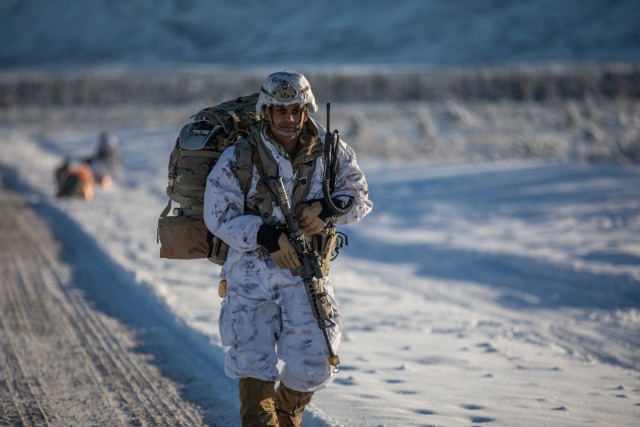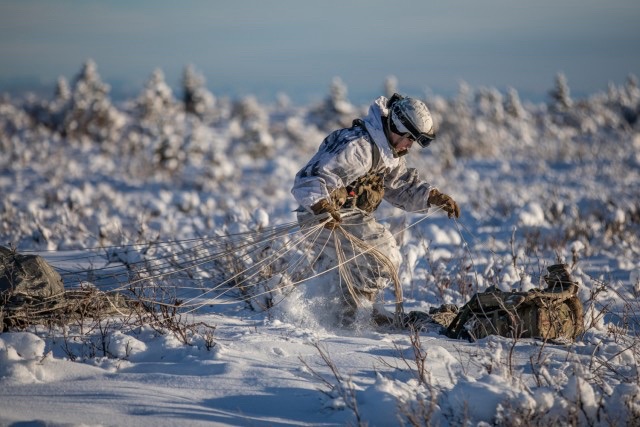
WASHINGTON — Braving subzero temperatures, about 9,000 Soldiers clad in white camouflage gathered in Alaska for a joint, multinational exercise.
Soldiers engaged in 40 training events over two weeks to prepare for combat operations in the northernmost region on Earth. During the largest multinational training exercise in the Arctic to date, called Joint Pacific Multinational Readiness Center 24-02, the Army simulated large-scale training operations in cold weather conditions for the first time. They tested next-generation weapons and operated cold weather, all-terrain vehicles or CATV, snow mobiles to traverse the terrain.
“What we’ve learned in this exercise is you’ve got to be ready for the full spectrum,” said Maj. Gen. Brian Eifler, 11th Airborne Division commander.
Five countries participated in training from Feb. 8 to Feb. 22 including a Canadian battalion and elements from Mongolia, Australia, Finland and Sweden. Exercises which align with the Army’s Arctic Strategy, stretched from Anchorage in the south to Utqiagvik, Alaska, the northernmost city in the U.S.
Climate change has made the Arctic more navigable, and as part of the Army’s Arctic Strategy, service must be ready to deter and defend against potential adversaries in the region, Eifler said. The guidance details how the service will train, organize and equip forces and partner nations.
The Army deployed an entire division during one joint exercise, which had U.S. Soldiers playing roles on both sides. Two battalions simulated enemy forces, equipped with artillery and rockets, Eifler said.
During that exercise, U.S. Soldiers learned to fight without air superiority and support. The friendly forces embarked on a 150-mile simulated, deep attack to train Army pilots to weave in and out of air defenses.
Soldiers, Airmen and Marines took part in a joint multi-battalion, joint force entry exercise into the Donnelly Training Center drop zone, north of Fort Greely. Soldiers also faced the challenge of disguising equipment in a snowy environment.
“In this battlefield, it’s very hard to be camouflaged like we used to,” Eifler said. “In some spectrums, you’re observed, whether it’s electronics, whether it’s physical, informational … across the cyber space … so we had to create windows to do a deep attack.”
Finally, troops engaged in an air assault simulation with American and Canadian Chinook helicopters, UH-60 Black Hawks and two battalions.
“That distance and scope and scale hasn’t been done before,” he said.
Soldiers also tested how the Next Generation Squad Weapon, the XM7 rifle, fared in frigid conditions and found parts of the weapon caused frostbite. Soldiers also had to adjust their survival measures. In addition to carrying more water, troops melted ice blocks and purified snow to help themselves hydrate.
“In this environment, if you stop, you freeze, and you get hypothermia,” Eifler said. “But at the same time you’re sweating, and you need more water. So that really challenged our sustainment.”
“All Soldiers require grit,” he added. “But Arctic grit … is a little bit more.”
They also had to keep electronic and digital equipment, including monitors and keyboards at a consistent temperature while sometimes operating them amid hurricane-strength winds.
Eifler said the 11th Airborne’s reactivation in 2022 gave Soldiers of that unit a greater purpose and reinvigorated Soldiers assigned to the unit. The Army also reassigned the 4th Infantry Brigade Combat Team and 1st Stryker Brigade Combat Team under the 11th Airborne.

“The forces up here had no real unity, purpose and identity,” Eifler said. “Being aligned as a division now — as warfighting capable force has increased readiness in the Indo-Pacific and for the Arctic. The [realignment] was extremely strategic. When you don’t have an identity, it’s really tough, no matter what line of work you’re in. And that was transformational up here.”
Eifler said that Soldiers who took part in the exercise can earn an Arctic skill identifier certifying that they served in a cold weather environment. Some troops even requested extensions to continue serving in the remote location.
In the past the Army has faced challenges with Soldiers experiencing depression and feelings of isolation. Eifler said that more new recruits have requested assignments in Alaska.
“Having that mentality and having that mindset that winter’s here and summer is short, and winter’s coming tomorrow; having that attitude has really changed the culture up here,” he added. “And we’re actually retaining people that have that expertise.”
Soldiers have also leaned on the Alaskan Inuit population who have taught Soldiers how to survive in Arctic conditions. For example, Soldiers learned to use ice drills to stake tents on the frozen tundra. Soldiers flew 500 miles north to Utqiagvik to perform a rapid infiltration test of the M142 High Mobility Artillery Rocket System or HIMARS. They tested HIMARS on a C-130 in -20 degree weather.
Pilots had to take extra steps to start Apache engines in cold weather conditions. They tackled a wide range of temperature changes from wind chills 40 degrees below to temperatures 40 degrees above. They studied the differences between light snow, heavier snow and wet snowfall, Eifler said.
“The temperature wasn’t consistent, which made it just a great testing environment to go full gamut on everything we needed to do,” Eifler said. “And then it really tested the grit of the Soldiers.”
The Soldiers treaded into new territory during the exercises. Eifler said that warrant officer pilots submitted white papers for Army manuals on how to operate Apaches in extreme cold. About 18 multinational observers took part including representatives from France, Japan, Nepal and Chile.
Next month, during Exercise Arctic Shock in Bardufoss, Norway, Army paratroopers will fly over the North Pole and perform an air entry operation. About 150 Soldiers from the 11th Airborne and 100 members of the Norwegian Army will take part in the exercise from March 18 to March 22.
“We’ll continue to push ourselves up here,” Eifler said. “And increase the scale and scope of these exercises. Because we’ve got to be better; we’ve got to be challenged. And we’ve got to help the Army resource us and structure us properly so we can meet those threats tomorrow.”
By Joe Lacdan, Army News Service

